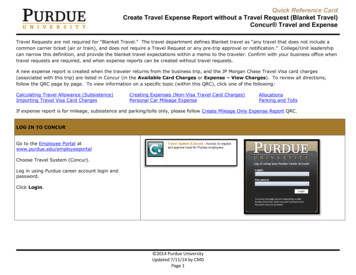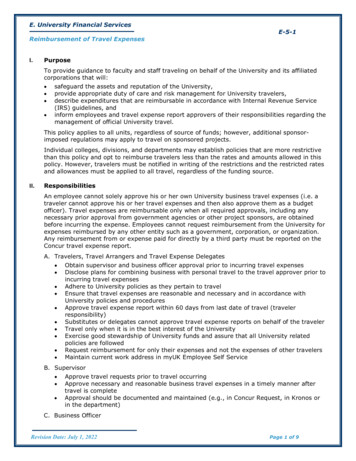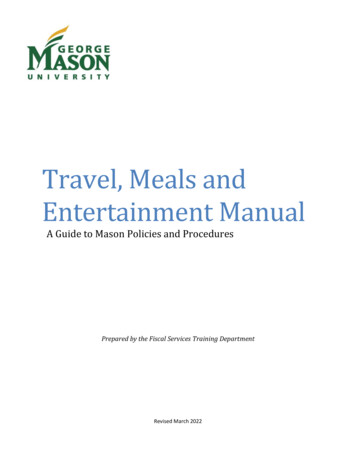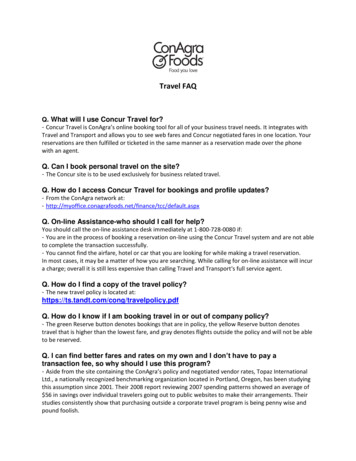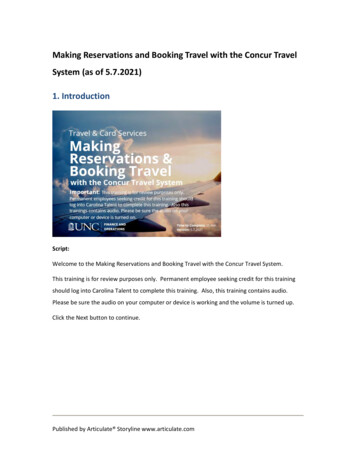
Transcription
PRODUCT DEVELOPMENT PLAN FOR TRAVEL AGENCYCase: Moon TravelThesisHasan Ahmed BhuiyanDegree Programme in International BusinessInternational ManagementAccepted . .
SAVONIA UNIVERSITY OF APPLIED SCIENCESUNIT OF BUSINESS AND ADMINISTRATION, KUOPIOPRODUCT DEVELOPMENT PLAN FOR TRAVEL AGENCYCase: Moon TravelHasan Ahmed BhuiyanBusiness Administration Bachelor’s thesisInternational BusinessInternational ManagementMay 2010
2SAVONIA UNIVERSITY OF APPLIED SCIENCESUNIT OF BUSINESS AND ADMINISTRATION, KUOPIODegree Programme, optionInternational Business, International ManagementAuthor(s)Hasan Ahmed BhuiyanTitle of studyProduct Development Plan For Travel AgencyType of projectDatePagesThesis12.5.201055 3Supervisor(s) of studyExecutive organisationMs. Anneli Juutilainen & Mr. Antti IireMoon TravelAbstractThe aim of t he thesis is to m ake a product deve lopment plan for Moon Travel Agency. And in doing so, I have tried to find out the possible busin ess extension of the existing products and also lookout for new product idea(s) for future improvement.The study is based on qualitative da ta. The im portance of the produc t plan for Travel agency andoverall importance of product strategies are based on secondary data. Company’s perception of theirmarket and products along with th eir future objectives assum ing the future m arket is analysed empirically. T he m ain theoretical backgrounds of this thesis werebased on developm ent processanalysis and the product is on focus.Moon Travel is only selling ticket s of IATA affiliated airline a nd hotels from different providerssince their start m ostly within He lsinki region. It is awarded the be st seller of different airlines’tickets for quite a few times since its establishment.This research plan indicates that with Moon Travel’s existing resources it is possible to expand theirbusiness in a greater fashion if the said suggesti ons are going to be im plemented rightly. The studyhas indicated effective solutions for product development of travel agency.KeywordsProduct, Travel agency, Package, Strategy
3CONTENTS1 INTRODUCTION . 51.1 Purpose of the study . 51.2 Reasons of the study . 61.3 Structure of the study . 62 LITERATURE BEHIND PRODUCT DEVELOPMENT . 82.1 Introduction of product planning . 82.2 Preliminary overview of product strategy . 92.2.1 Objectives. 92.2.2 Product development process. 122.2.3 Role of market research during product development . 132.3 Marketing Mix . 152.3.1 Product . 152.3.2 Price . 192.3.3 Promotion . 222.3.4 Place . 242.4 Competitor analysis . 252.5 SWOT analysis . 262 RESEARCH METHOD AND PROCESS . 283.1 Choice of methodology . 283.2 Data collection . 303.2.1 Secondary sources . 303.2.2 The Empirical study . 303.2.3 Validity of the study . 323.2.4 Reliability of the study . 324 PRODUCT DEVELOPMENT PLAN FOR CASE COMPANY. 344.1 Introduction of Moon Travel. 344.2 Executive summary . 354.3 Product development strategy . 364.3.1 Active and effective development . 364.3.2 Gradual development . 364.4 Description of the proposed new product idea. 384.4.1 Vietnam as a holiday destination . 384.4.2 Product partner. 394.5 Am adeus. 41
44.6 Price strategy . 414.6.1 Ticket pricing . 424.6.2 Pricing for a package trip . 424.7 Promotional strategy . 454.7.1 Advertising . 454.7.2 Attractive offers . 464.8 Place strategy . 464.9 Competitors review. 464.10 Current market trend . 474.11 SWOT analysis of Moon Travel . 484.12 Continual growth of proposed product plan . 495 CONCLUSION . 51REFERENCES .53APPENDICES .56APPENDIX 1 . 56APPENDIX 2 . 57APPENDIX 3 . 58
51 INTRODUCTION1.1Purpose of the studyThe purpose of m y thesis is to find out di fferent possibilities for the developm ent ofnew trav el agency p roducts and id eas when compared with older products. Presentmarket trends towards new technologies and ideas pushed me to decide preliminary tosort out a possible and suitable product strategy by offering new product ideas and bydeveloping existing products with the possibility of future business growth and expansion.The research work covered of around five months since my joining at Moon Travel(MT) as a trainee. The core objective of the research is to form ulate a product development plan for the company so they can have balanced sales across the year roundand can have stable flow of customers as well.In order to develop a product plan and to increase sales, a product development strategy is necessary for the com pany. So, the m ain task is to find out, a product develop ment plan as a f inal research work f or MT. In doing tha t, the rese arch work will f indout new wa ys to reach custom ers by deve loping current p roducts and by adding newproducts in product line. In addition to planning the focus is also on the sales volumeand sales revenue. Moreover, for a new product, the goal is to m ake a package tour toVietnam.The study provides an outline of MT’s curren t situation, its competitors’ analysis andopportunities for future business as well as a guideline of product development strategy. After the completion of my extended analysis on produc t development, it is possible to apply the research resu lt on the targ eted com pany for the real b enefit. As th eresearch will cover all the parts of the topi c and also will deliver an effective d escription of those, it is log ical that the r esearch plan of business expansion by adding newproducts and developing existing products will benefit the case company.
61.2 Reasons of the studyWhile working as a train ee at MT it was visi ble that the trav el agency b usiness is anever changing industry where success knocks if we think on scopes and im plementthose different scopes to welcome new ideas. MT’s Managing Director (MD) Mr. Abrar Murad 2009 suggested being an em ployee of a sm all company we have to handlevarious tasks. So that MT’s em ployees ha d the opportunity to m anage custom er sodearly as a custom er service officer as we ll as perform ing other office tasks too. But,above all, finding the possibility of new business ideas is the core part of a com panyloyal employee to survive with the trem endous competitive nature of th e present g lobalized job market. The definition of a travel agency is what MT’s Managing Directorsaid, ‘you will be a professional of different interests rather than of any specific.’ Mu rad A (2009)With the existing resou rces and tech nologies of MT, it is af fordable and practical towelcome new product ideas or existing product developments. In adding new productsit is n ecessary to establish a con crete contact with product p artners such as d ifferentair service providers, tour operators and or hot el providers. So that it will be easier forthem to look for new products th at will suit th eir cus tomers’ requirem ents and willalso increase MT’s profit.However, it should also be noted that de veloping products, means developing existingproducts. T his will in clude develop ing cust omers’ ratio, providing stro ng after-salessupport, pro viding th e v alue of the mone y, website d evelopment with multiple lan guages etc.1.3 Structure of the studyThis thesis is divided into three par ts. These segments have individual importance toproduce an effective solution for Moon Travel. In the introductory part, I have introduced the research top ic and its features. It includes the purpose and problem s of theresearch.In the nex t part titled with lite rature review is the description of the market researchduring product developm ent and de signing facts. Moreover, knowledge m anagementin th e ea rly stage of p roduct dev elopment is als o in f ocus. Additiona lly, I hav e a lso
7discussed different sub topics of the m arketing m ix where products are in the spotlight. The research m ethod and process are in the third pa rt, which includes the datagathering process and analysis to find out re sult of this res earch. The data gatheringprocess includes an empirical part and secondary part. The most important part of thisthesis is the f ourth part, which descr ibes the outline of the thesis and produces effective solutions. Later in the conclusio n, I ha ve described and summarized m y researchresults.
82 LITERATURE BEHIND PRODUCT DEVELOPMENT2.1 Introduction of product planningProduct planning refers to the outcom e of th e final product that is m arketed to a spe cific customer category and marketing area. The real product comes after quite a lot ofentrepreneurial and m anagerial processing th rough a com pany’s internal and externalactivities. This a ctivity includes a co mpany’s mission and vision of their future business, customer and corporate benefits and pr ospective growth of the business. Finallyafter analyzing all those features, a com pany must shape a product for real benefit.The product comes with its shape, design, pr ice, features and cautions. The discussionbelow will broaden this analys is for developing and launching a new pr oduct of a travel agency, starting with a proper business plan and then illustrating a product development plan and process.Formal planning can be beneficial to all ty pes of com panies, large or sm all, new orestablished. It provides a company with a clear statement of purpose, a vision of futuremotivation, standards for control and management. Sound planning helps the companyto run acco rding to its g oal and strategy and there is also th e possibility of development and growth. (Kotler 1997, 676-677)Kotler (1997, 676-677) again de fines this type of plan ning with annual long-ter mplanning and strategic planning. Annual plan ning analyzes a com pany’s current business situation and its future possible growt h. While strategic plannin g analyzes theprocess of growth and the changing market opportunities.A proper product plan is necessary for an entrepreneur and is really for his or her benefit. The entrepreneur needs to develop hi s or her idea in a paper and should includewhy and how type questions. It is always necessary to think about the plan before in vesting time and money. (Li 2002, 39)
92.2 Preliminary overview of product strategyIn this ever changing era new techn ologies are com ing almost every day, creation ofnew products is boosting m arkets much m ore than yesterday and flexible custom erservice is rising the sales volume and making markets more competitive than ever.Here we com e across two very realistic que stions; (i) how do com panies revise theirstrategy and deploy it to fit with th eir corporate habit? And (ii) how does it perfor mthroughout the development process?According to Luis & L uis (2006, 1 -8), analysin g com petitors’ future p ossibilities ofgrowth is the core part to revise in the form ulation of a strategy. Moreover, earlycommunication between senior m anagers and project m anagers can guarantee an effective deployment of the strategy. The company should have a link between the senior m anagers and the staff to involve co -operation throughout the product development process.2.2.1 ObjectivesLuis & Luis (2006, 1-8) describes, the objectiv e of a company is to identify a syste matic way to run com panies’ strategic objectives throughout the product developm entprocess. The final task is to produce an elaboration of obj ectives that integrates twolargely used methods: ‘Balanced Scorecard (BSC) and the Quality Fun ction Deployment (QFD). These m ethods comprehend the elaboration of a m atrix that relates bothBSC strategic objectives and customer needs used for new products development.-Balanced Scorecard (BSC)BSC is to transla te the company’s vision a nd strategy through a consistent set of performances. Its m ain objective is to continue a balanced growth am ong all the departments of the organization.Basically BSC provides answers of the following questions:
101.Objectives that should achieve profit.2.Values that should offer the customer to achieve com pany’s financial objectives.3.The ways that a company may learn and innovate to achieve their targets.Monitoring of the objectives achievem ent, depends on the definition of the perform ance indicators, targets, and action plans with respective responsibility.-Quality Function Deployment (QFD)According to Guinata & Praizler (1993), Quality Function Deployment is a simple andlogical m ethod, which is i mplemented thr ough a set of m atrices. The QFD m atriceshelp to determine exactly what the customer wants, how the competitors meet the customer’s needs and where there are opportunitie s niches to be filled out. In add itionwith that, QFD technique is useful to ch eck whether the co mpany has the necess aryresources to fulfil successfully the market niches with the correct quality levels. Thereare some similarities and differences in th e above mentioned methods. Below in table1 and table 2, I have compared those:
11Table 1. Similarities between BSC and QFD method. Luis & Luis (2006, 1-8)Comparison CriteriaBSCQFDMethod StructureInvolves the com pany inInvolves the organization instrategic objectivesproduct developmentprocessInvolved TeamManaging directors, planMultidisciplinary te am in-makers, senior personnelcluding engineering, m arketing, m anufacturing departmentsPerformanceOperate the company Supports clients needsstrategySupports guarantying theSupports com pany indi-achievement of a productviduals in order to achievethat fulfils customer needsa common goalTable 2. Differences between BSC and QFD. Luis & Luis (2006, 1-8)Comparison criteriaBSCQFDScopeComprehends the entireConcentrates on the prod-company and deploy stra-uct developm ent processtegic ob jectives in all le-and assists developmvels of the companyteamObjectives rela ted to theDevelopment process isObjectivesfinancial, customer, incorporated with clieentntsprocess and learn ing p ers- and the m anufacturing deResultspectivespartmentOrganizational relationshipRelationship am ong c us-among the objectivestomer needs, product requirements, m anufacturingoperation
12The development of a new product has becom e the hot topic around the world in regards to manufacturing companies. It is pr oved that the effective development of newproducts has a superb impact on a company’s costs, quality, customer satisfaction andoverall company’s strategy.The development process of the company is known as an Innovation P ipeline, or theInnovation Funnel.2.2.2 Product development processTo grow a business m ore, a firm needs to develop or diversify their products. Com petition, consum er dem ands and developed technology will boost a company to findadditional developments in their products. Even products that have been popular foryears need to develop their features and services. The strategic product developm entprocess will ensure sustainabl e growth of a company. First of all this process is tim econsuming and costly. It needs research a nd market analysis. Also a company has tounderstand the demand in the market. The product developm ent process goes throughseveral stages. (Luis & Luis 2006, 1-8)In the table below it has described more about the process:
13Table 3. Development Process Luis & Luis (2006, 1-8)Pre BriefingBriefingViabilityViabilityExecutive PlanLaunchLaunchIdeas formal-ConceptTechnicalFinancialProject lityassessmentPilot batchProjectmonthand totypeintoprod-evaluationuctproductionConclude strat-PurchaseegymaterialsProductEstimateto launch aperformancecostspilotassessmentDeploy on-ceptintoprototypesnew productandrequiredpro-jectinvestmentsPart one starts with several discussions w ith a com pany’s staff and senior m embers.Everyone gives their comments and agrees on a specific goal. Later with product reality som eone on behalf of the com pany show s the real product m odel. After gettingapproved from the board of director, an estimation of financial requirements is appliedon this and a project can be ready to im plement. In the beginning, the result of newproduct implementation comes after a 1-6 m onth tim e period and then the com panycan get an understanding of the product’s future.2.2.3 Role of market research during product developmentIn order to achieve optim al product deve lopment knowledge, m arketers need to com bine process m anagement technology w ith product developm ent technology. Bothfactors can develop speedy production, quali ty product and m inimize costs, developthe understanding of clients’ n eeds etc. In Figure 1, I have described several steps ofthe product development process.
14System of Product Development processPortfolio Management-Search for market information-Search for competitor’s information-Financial analysis-Analysis of existing resourcesetc.-Revised version-Survey market information-Understanding technical ability-Selection of ideas etc.New product strategyRevisions Gates-Survey client’s needs-Find out product concept-Economical analysis-Customers perceptionIdentification of opportunitiesConcept definition and testProduct and process development-Detail of product features-Preparing a test version-Evaluate the market response-Prepare the process of productionFigure 1. Steps of Product development Process. Luiz & Fatima (2001, 5-10)According to Cooper et al., (1998), in thesary to analyze the set ofproduct portfolio m anagement it is neces -products in term s of m arket, financial, and technologicaldimensions along with internal recourses.According to Kotler (1994, 676), ideas fornew products can originate from manysources- co nsumers response, scien tists, com petitors s trategy, top m anagement etc.However, identification of oppor tunities such as a revised version of ideas, marketinformation and ideas, use of technology for the selection of ideas can be useful torefurbish the results of achievem ent. Later with the best ideas, a new product conceptcan be obtained. From this product concept; it must be translated from the market language into the project technological environment, which is a reason why process management technology and product management technology have combined.
15The product development process entitles actions inside and outside of a company andbetween several sectors of developm ent processes. Market research is recomm endedfor product developm ent to get the success of data gatherin g, its processing and theimplementation of new concept and finally in return to have an outstanding result.2.3 Marketing MixThe 4p’s of the m arketing mix are the parameters that a m arketing manager can manage to achieve com pany’s target. Changes happening on these param eters are subjectto changes in com panies inside or outsi de environm ent. (Kotler & Arm strong 1997,263-266)The marketing mix is like a recipe of a products strategic position in the market. So toachieve success in a company’s strategic approach the 4p’s of marketing are the maintools. (Culliton 1948.).In the Figure below, I have indicated the 4p’s of the marketing mix:FigureProductPricePromotionPlace2. Marketing mix (Kotler & Armstrong 1997, 263-266)2.3.1 ProductA product is a good or service or the com bination of both wh ich is m ade to satisfy agroup of people in a market where people can give a value in exchange of any specificgoods or services. Comm ercially, a product means something that belongs to a com pany or a person which is produced and delive red for a certain m arket with a certainprocess and in exchange of a value is calle d product. This can be tangible or intangible. (Griffin & Ebert 2004, 308-313)
16Considering custom er’s needs m arketers m ust deliver a des criptive package quotin gwhat a custom er really buys when they pur chase a product. This kind of understandings m eans that every product has a value inits pricing which pr ovides benefits tosatisfy customer needs a nd wants. Only th is method ensures that m arketers formulatestrategies effectively. (Griffin & Ebert 2004 308-313)A product can be tangible or intangible. Inboth cases custom ers get value of whatthey buy. For exam ple, a rechargeable batt ery with 10 hours long lasting capacity. Inaddition, to attract custom er’s m arketers can also provide: batteries that have twoyears guarantee. So then the buyer becom es happy to know this after sales servicetoo. (Griffin & Ebert 2004, 308-313)Today buyers expect to receive products or services with a greater value and with areasonable price. Mark eters call th is the ‘v alue package.’ Below are som e possibleattributes of a package trip (travel agency product) that a custom er might consider intime of purchasing the services:-Crystal clear trip itinerary-choices from a variety of destinations-choices of accommodation and transportation-reasonable price range-simple process of purchasing-credit card protection-comfortable and safe-insurance services, etc
17Though package trips from a travel agency is work involving different m edia such asAirline Company, hotel and others. In that case feedback fr om the custom er goes tothe travel agency as well as service provider too. (Griffin & Ebert 2004, 308-313)Classifying Goods and ServicesThere are two types of buyers according to different groups of products: (i) Consumerproducts interest group and (ii) Service interest group.But surprisingly the m ethods of m arketing ar e quite sim ilar. Both types of productsmarket to th e custom ers through newspapers , m agazines, radio, TV, billbo ards, etc.(Griffin & Ebert 2004, 308-313)GoodsThe definition of goods refers to a tangible object that is econom ically benefited andmade for consumption and to satisfy a certa in group of people. (Griffin & Ebert 2004,308-313)More specifically, when people go into a shopping mall, what they put in a shoppingbasket are all tangible goods. Purchases from online stores seem to be good as long asthis product is shipped to the buyers address. (Griffin & Ebert 2004, 308-313)ServicesServices are a kind of activity that one party can offer to another. This kind of productmay or m ay not be related with a physicaltouch. Activities such as renting a hotelroom, buying a flight ticket, hair cutting, c onsultancy, etc are service related products.(Kotler & Amstrong 1997, 263-266)A company must consid er four special ch aracteristics when designing m arketing programmes, these are: intangibility, inseparability, variability and perish ability.
18Figure 3 has described these more:IntangibilityInseparabilityServices cannot beseparated from theirprovidersServices cannot beseen, tasted, felt, heard,or smelled before purchaseServicesVariabilityQuality of servicesdepends on who provides them and when,where, and howPerish abilityServices cannot bestored for later sale oruseFigure 3. Service marketing. Kotler & Armstrong (1997, 263-272)Service intangibility m eans, that a servic e cannot be seen before they are bought orserved. For example, an airline ticket bought before the flight is nothing but a promiseof a safe and comfortable journey of a passenger from one destination to another.Service Inseparability means that a service cannot be separated nor from the customeror from the provider. F or exam ple, consultants who consult to their custom ers bothparty affects with the outcome of the service.Service Variability m eans, the quality of se rvice at the tim e it is g iven. For exam ple,in a travel agency one agent m ay be fluent and faster than another agent, in deliveringcustomer services and solving their queries.Service Perish ability means that a service cannot be stored for later sale. For exampleif a patient m issed his or her doctor’s appoi ntment, a doctor m ay charge an extra feebecause the service valu e existed on ly at th at point of the tim e scheduled. (Kotler &Armstrong 1997, 263-266)
192.3.2 PriceIn this process of the m arketing m ix, pric ing com es after prepar ing the product. Inpricing managers decide the value of a product according to its cost and profit margin.The discussion below is about the objectiv e of product pricing and then elaborate onsome major segments and tools that companies follow in pricing their products.Objectives of pricingUsually a company m akes pricing to m eet business objectives but it also includes satisfying other objects related to building up a product. Prici ng of a product differs indifferent markets. Som e com panies have a monopolised m arket with their uniqueproduct and some have only the right to do business on a specific market. Pricing alsodepends on corporate im age, social value, market condition, and geographical condition or situation. (Ricky & Ronald 2004, 319-366)Profit-Maximizing ObjectivesMaximizing profit is som etimes very tricky. Low prices som etimes give a bad im ageabout the company or on the other hand it can lead to high volum e. A high price sellslow volume of products but keep a standard of quality and com pany i mage. For example, low prices f rom Tale communication servic e pr oviders enab le them to se llmore, but places huge pressure on th eir network in regard s to volume. But high pricecan attract more custo mers with a high quality of services and benefits. On the otherhand high prices return a com pany’s cost and effort within a short time but low pricestake time and often take longer than expect ed. To reduce this kind of pr oblem companies try to s et a re asonable price which can return minimum profits but will keep th evalue of the company and customer. (Ricky & Ronald 2004, 319-366)Market Share ObjectivesEstablishing m arket share in different m arkets often differs from one m arket to another. Sometimes it’s easier than expected and sometimes it’s take time to achieve thisobjective. In the long run, a business must make profit to keep it running. A new com-
20pany can set their prices lower in the beg
2 LITERATURE BEHIND PRODUCT DEVELOPMENT 2.1 Introduction of product planning Product planning refers to the outcome of the final product that is marketed to a spe-cific customer category and marketing area. The real product comes after quite a lot of entrepreneurial and managerial processing through a company's internal and external activities.

